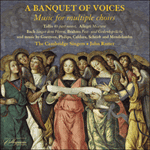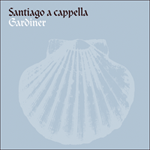This seems to have been the composer’s only piece (surviving complete) for twelve voices in three choirs. Guerrero had it printed twice, first in 1589 and again in his final collection (1597). Two lone high voices begin; at ‘Tres sunt’ three voices are exposed on their own. At ‘Plena est omnis terra …’ the grand tutti join in massive chords. The Trinitarian symbolism is obvious. Here different choral and instrumental groups enhance the separation of the three choirs and their dramatic potential.
from notes by Bruno Turner © 1999
Ce motet semble être la seule œuvre de Guerrero écrite pour douze voix, à trois chœurs. Le compositeur la fit imprimer deux fois, d’abord en 1589, puis dans son dernier recueil, en 1597. Deux voix aiguës commencent, seules; à «Tres sunt», trois voix sont exposées toute seules. À «Plena est omnis terra …», le grandiose tutti fait son entrée, dans des accords massifs. Le symbolisme trinitaire est évident. Ici, différents groupes choraux et instrumentaux rehaussent la séparation des trois chœurs et leur potentiel dramatique.
extrait des notes rédigées par Bruno Turner © 1999
Français: Hypérion
Dies scheint das einzige Stück des Komponisten für zwölf Stimmen in drei Chören gewesen zu sein. Guerrero gab es zweimal in Druck, das erste Mal 1589 und dann noch einmal in seiner letzten Sammlung (1597). Zwei hohe Stimmen machen für sich allein den Anfang; bei ‘Tres sunt’ werden drei Stimmen allein dargeboten. Bei ‘Plena est omnis terra …’ kommt es zum eindrucksvollen Tutti in massiven Akkorden. Die Dreifaltigkeitssymbolik ist unübersehbar. Hier verstärken verschiedene Chor- und Instrumentengruppen die Aufteilung der drei Chöre und ihr dramatisches Potential.
aus dem Begleittext von Bruno Turner © 1999
Deutsch: Anne Steeb/Bernd Müller
Esta parece haber sido la única pieza del compositor (que nos ha llegado completa) para doce voces distribuidas en tres coros. Guerrero la editó en dos ocasiones, primero en 1589 y de nuevo en su última colección (1597). La inician únicamente dos voces agudas; en ‘Tres sunt’ aparecen tres voces en solitario. En ‘Plena est omnis terra …’ se incorpora el grandioso tutti en rotundos acordes. El simbolismo de la Trinidad es evidente. Aquí los diferentes grupos corales e instrumentales realzan la separación de los tres coros y su potencial dramático.
extraído de las notas de Bruno Turner © 1999
Español: Luis Gago


 A banquet of voices
A banquet of voices Santiago a cappella
Santiago a cappella The Guardian» More
The Guardian» More
